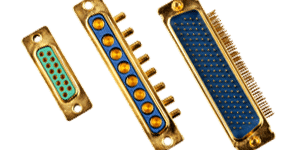Space Connectors
Not just anyone or anything can make it into space these days. Space travel is expensive, exclusive, and highly selective, so when the space industry requests space connectors to assist their electronic equipment, only the best products make the grade. Ideally, space connectors are not only efficient at their job, they are also capable of standing up to harsh environmental conditions, being reliable and long lasting (because repair is typically impossible once you’ve left the earth’s surface), and still remain unimposing (so that it won’t disturb the other equipment on board). The list of requirements is long, but the job is an important one. Space connectors must satisfy all these demands if they wish to catch that rocket to the moon.
Space Connectors Defined
 Space connectors are utilized within the electronic equipment used in space applications, whether on a spacecraft or a satellite. To qualify for this elite task, the connectors must be tested and approved by NASA or the European Space Agency (or the space agency of whatever country they will be representing). Like all devices used in space, they have to meet stringent testing for outgassing (the release of trapped air) and residual magnetism (which can interfere with other mechanisms) to be suitable for use in space applications. Outgassing and residual magnetism can adversely affect nearby components. NASA and the ESA have similar requirements, though sometimes they vary for a particular mission.
Space connectors are utilized within the electronic equipment used in space applications, whether on a spacecraft or a satellite. To qualify for this elite task, the connectors must be tested and approved by NASA or the European Space Agency (or the space agency of whatever country they will be representing). Like all devices used in space, they have to meet stringent testing for outgassing (the release of trapped air) and residual magnetism (which can interfere with other mechanisms) to be suitable for use in space applications. Outgassing and residual magnetism can adversely affect nearby components. NASA and the ESA have similar requirements, though sometimes they vary for a particular mission.
Due to their unique mission, space connectors have special requirements to satisfy in regard to their shape, size, and materiality (not unlike military connectors). Space connectors must be compact, first of all, because there is only so much room on a space vehicle. Weight is another major consideration. Costs to launch a payload into space is directly related to the weight of that payload so lightweight connectors are desirable. But space connectors can’t just be small and lightweight, they have to be extremely reliable as well and they must be able to withstand severe environmental conditions like shock, extreme temperatures and vibration. The material the connector is made out of is especially important for space connectors because of the emphasis on low levels of residual magnetism and outgassing. Many manufacturers create their connectors out of elastomers and plastics. Some of these materials contain compounds that may outgas over time, so component suppliers often have these compounds removed during the manufacturing process (usually through a bake-out process).
USES
Three major categories of connectors are used in space flight application: D-subminiature, micro-miniature and circular. When an engineer is selecting a connector for use in space, he/she considers the type of application and size requirements as well as the strenuous physical expectations. D-sub and Micro-D connectors are widely used on PCB, panel mount and basic cable applications, while circular connectors are used for heavy-duty cable and panel mount applications.
PRODUCTS
Positronic is a well-respected supplier of high performance D-subminiature connectors that meet the stringent qualifications for use in space flight. Although they are qualified to the Goddard Space Flight Center S-311 and MIL-DTL-24308 Class M specifications, these space connectors are suitable for use in any application requiring high performance, non-outgassing and low magnetic characteristics. Offered in a broad range of termination styles, contact variants, and with many available accessories (including lightweight aluminum hoods/backshells), these connectors are highly reliable. They feature connector saver options, fixed and removable contacts, and the female contacts utilize the patented PosiBand closed entry design. Plus, in addition to standard and high density contact variants, mixed density (Combo-D) options are also available to facilitate the combination of power, signal, coax and high voltage.
Find Your Sales Agent
We cannot locate a sales agent for the country you selected.
Please view our global locations and contact the facility that is most geographically near you.